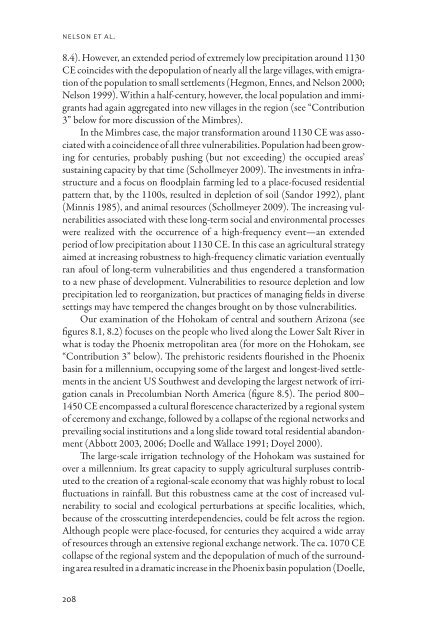free download - University Press of Colorado
free download - University Press of Colorado
free download - University Press of Colorado
You also want an ePaper? Increase the reach of your titles
YUMPU automatically turns print PDFs into web optimized ePapers that Google loves.
Nelson et al.<br />
8.4). However, an extended period <strong>of</strong> extremely low precipitation around 1130<br />
CE coincides with the depopulation <strong>of</strong> nearly all the large villages, with emigration<br />
<strong>of</strong> the population to small settlements (Hegmon, Ennes, and Nelson 2000;<br />
Nelson 1999). Within a half-century, however, the local population and immigrants<br />
had again aggregated into new villages in the region (see “Contribution<br />
3” below for more discussion <strong>of</strong> the Mimbres).<br />
In the Mimbres case, the major transformation around 1130 CE was associated<br />
with a coincidence <strong>of</strong> all three vulnerabilities. Population had been growing<br />
for centuries, probably pushing (but not exceeding) the occupied areas’<br />
sustaining capacity by that time (Schollmeyer 2009). The investments in infrastructure<br />
and a focus on floodplain farming led to a place-focused residential<br />
pattern that, by the 1100s, resulted in depletion <strong>of</strong> soil (Sandor 1992), plant<br />
(Minnis 1985), and animal resources (Schollmeyer 2009). The increasing vulnerabilities<br />
associated with these long-term social and environmental processes<br />
were realized with the occurrence <strong>of</strong> a high-frequency event—an extended<br />
period <strong>of</strong> low precipitation about 1130 CE. In this case an agricultural strategy<br />
aimed at increasing robustness to high-frequency climatic variation eventually<br />
ran afoul <strong>of</strong> long-term vulnerabilities and thus engendered a transformation<br />
to a new phase <strong>of</strong> development. Vulnerabilities to resource depletion and low<br />
precipitation led to reorganization, but practices <strong>of</strong> managing fields in diverse<br />
settings may have tempered the changes brought on by those vulnerabilities.<br />
Our examination <strong>of</strong> the Hohokam <strong>of</strong> central and southern Arizona (see<br />
figures 8.1, 8.2) focuses on the people who lived along the Lower Salt River in<br />
what is today the Phoenix metropolitan area (for more on the Hohokam, see<br />
“Contribution 3” below). The prehistoric residents flourished in the Phoenix<br />
basin for a millennium, occupying some <strong>of</strong> the largest and longest-lived settlements<br />
in the ancient US Southwest and developing the largest network <strong>of</strong> irrigation<br />
canals in Precolumbian North America (figure 8.5). The period 800–<br />
1450 CE encompassed a cultural florescence characterized by a regional system<br />
<strong>of</strong> ceremony and exchange, followed by a collapse <strong>of</strong> the regional networks and<br />
prevailing social institutions and a long slide toward total residential abandonment<br />
(Abbott 2003, 2006; Doelle and Wallace 1991; Doyel 2000).<br />
The large-scale irrigation technology <strong>of</strong> the Hohokam was sustained for<br />
over a millennium. Its great capacity to supply agricultural surpluses contributed<br />
to the creation <strong>of</strong> a regional-scale economy that was highly robust to local<br />
fluctuations in rainfall. But this robustness came at the cost <strong>of</strong> increased vulnerability<br />
to social and ecological perturbations at specific localities, which,<br />
because <strong>of</strong> the crosscutting interdependencies, could be felt across the region.<br />
Although people were place-focused, for centuries they acquired a wide array<br />
<strong>of</strong> resources through an extensive regional exchange network. The ca. 1070 CE<br />
collapse <strong>of</strong> the regional system and the depopulation <strong>of</strong> much <strong>of</strong> the surrounding<br />
area resulted in a dramatic increase in the Phoenix basin population (Doelle,<br />
208





